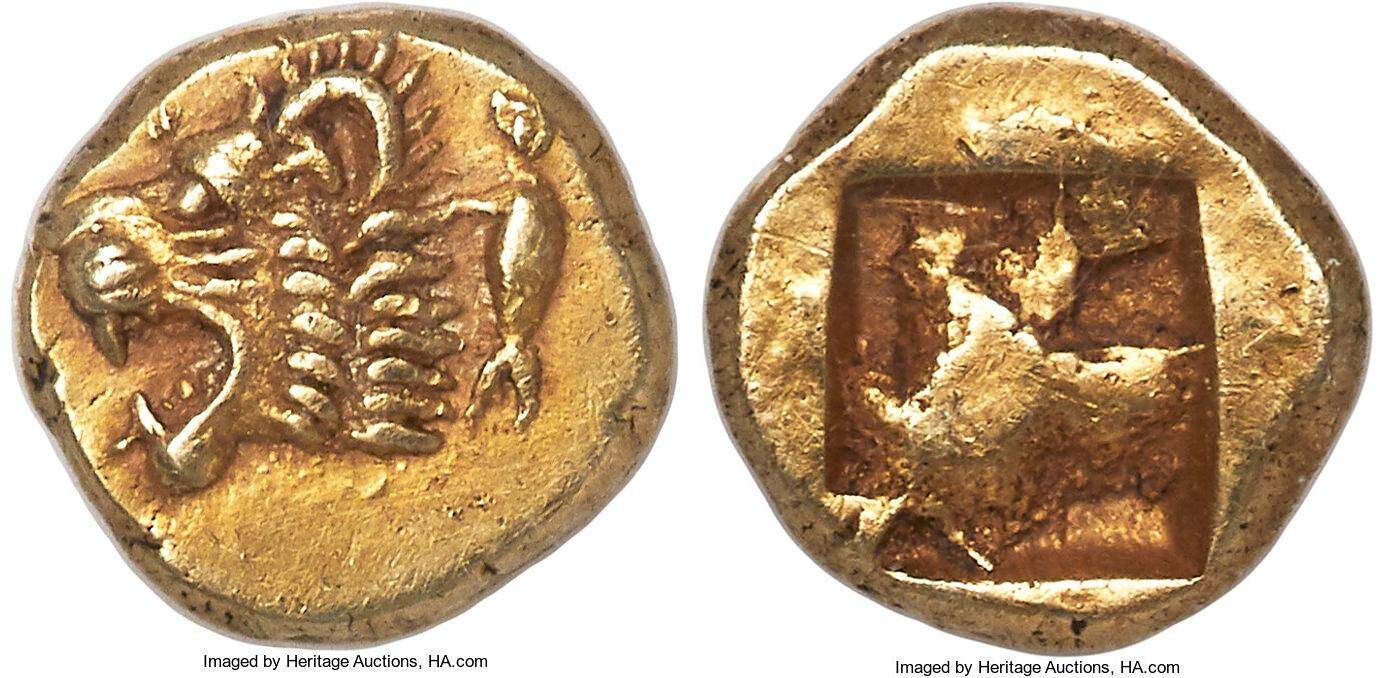AC 220 - Phocaea, electrum, quarter hecte, 625/600-522 BC
From SILVER
600 BCE - 522 BCE Electrum 2,789 kg
Description
| ObverseInscription or printing placed on the obverse.: | Head of roaring lion left, seal upward behind. |
| ReverseInscription or printing placed on the reverse.: | Incuse square punch with irregular interior surfaces. |
Mint and issuing power
| MintIdentifies the place of manufacture or issue of a numismatic object.: | Phocaea | Ancient regionAncient region.: | Ionia | Modern countryModern country: Turkey | AuthorityIdentifies the issuing power. The authority can be "pretended" when the name or the portrait of X is on the coin but he/she was not the issuing power. It can also be "uncertain" when there is no mention of X on the coin but he/she was the issuing power according to the historical sources: |
Chronology
| FromIdentifies the initial date in a range assigned in a numismatic context. | 600 BCE | toIdentifies the final date in a range assigned in a numismatic context.. | 522 BCE | PeriodTime period of the numismatic object.: Classical 480-323 BC |
Physical description
| MetalThe physical material (usually metal) from which an object is made.: | Electrum http://nomisma.org/id/el | Median weightMedian of the weights of numismatic objects (in grams). in grams | 0.60 | DenominationTerm indicating the value of a numismatic object. Examples: tetradrachm, chalkous, denarius.: | quarter hecte |
StandardStandard.: |
Image

AC220 Phocaea.jpeg [1]
References
| Die study referencePublication of the study: | Bodenstedt 19811Bodenstedt 1981, émissions 1-28. | ||
| Coin series referenceReference to coin series study: | RQEMAC2RQEMAC, n° 220 | ||
Obverse dies distribution
| FrequencyFrequency of specimen in distribution. ᵖ | Number of obversesNumber of obverse dies. ᵖ (o) | % (o) | Number of coinsNumber of coins. (n) | % (n) | Die nameName(s) of the die(s). |
| 1 | 7 | 41.18 | 7 | 15.91 | 2.1b, 12b, 12c, 12d, 13a, 13b, 20c |
| 2 | 3 | 17.65 | 6 | 13.64 | 2.2a, 12e, 20d |
| 3 | 3 | 17.65 | 9 | 20.45 | 2.1a, 12a, 20b |
| 4 | 2 | 11.76 | 8 | 18.18 | 15a, 20a |
| 6 | 1 | 5.88 | 6 | 13.64 | 2.2b |
| 8 | 1 | 5.88 | 8 | 18.18 | 2.2c |
| Total | 17 of 17 | 100 | 44 of 44 | 100 |
Reverse dies distribution
no distribution is available
Quantification
| Number of obversesNumber of obverse dies. ᵖ (o) | 17 | Number of singletons (o1)The number of singleton coins. ᵖ | 7 |
| Number of reverse diesNumber of reverse dies. (r) | NC"NC" is not a number. | Number of coinsNumber of coins. (n) | 44 |
| Coins per obverse dieNumber of coins per obverse die. (n/o) | 2.59 | Coins per reverse dieNumber of coins per reverse die. (n/r) | |
| Reverse per obverse ratioRatio of obverse dies divided by reverse dies. (r/o) | Percentage of singletons (o1)number of coins (n) divided by the number of singletons (o1) ᵖ | 41.18 % | |
| Original number of dies (O) (Carter 1983 formula)The estimation of the number of coins according to Carter 1983 ᵖ | 23.24 | Coins struck if 20,000 as average productivity per dieCoins made if the average productivity for obverses (according to Carter) is 20,000. ᵖ | 464,800 |
| Original number of dies (O) (Esty 2011 formula)The estimation of the number of coins according to the singleton formula in Esty 2011 ᵖ (O) | 27.7 | Survival rate if 20,000 as average productivity per dieSurvival rate if average productivity is 20,000. ᵖ | 0.00009 |
| Coverage (o = % of O) (Esty 1984 formula)Esty 1984 - coverage (% of O) ᵖ (o = % of O) | 84.09% | Die productivity if survival rate 1/2,000Average productivity if survival rate is 1/2,000. ᵖ | 3,786.57 |
| Weight of silver (in kg) if 20,000 coins per die (O = Carter formula)Carter 1983 * Median weight * 20000 (*10 if gold or electrum) ᵖ | 2,789 kg <br /> 2,789 kg | Die productivity if survival rate 1/5,000Average productivity if survival rate is 1/5,000. ᵖ | 9,466.44 |
Remarks